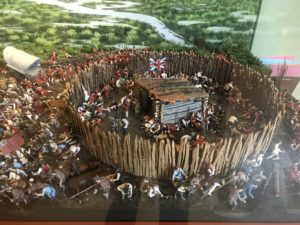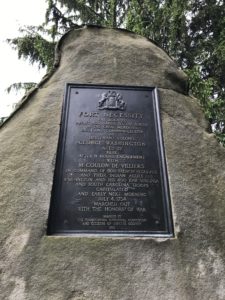Last week I wrote about building Fort Necessity. This week the history lesson continues with the Battle of Fort Necessity. To recap, George Washington and his men attacked a small group of Frenchmen on May 28 and killed their leader, Captain Jumonville. Colonel Washington gathered his men in the Great Meadows and built a small fort of necessity. Reinforced by Captain Mackay, Washington and his men wait for the French and Indians to come for a battle.
The 700 French and Indian troops were led by Captain Louis Coulon de Villiers, brother of Captain Jumonville. They arrived at the fields around Fort Necessity around 11 a.m. on July 3, 1754. At first it appeared the French would attack on the open field of combat. Colonel Washington and Captain Mackay led their men out of the entrenchments in an orderly formation. But the French and Indians immediately melted into the woods surrounding the meadows. From this protected position they fired on the men in the field, who quickly retreated to the entrenchments.

Colonel Washington soon realized how weak his position was. He appreciated the discipline of the South Carolina Independent Company who took up position in the fiercest fighting. Despite the open ground, the French were still able to fire from the woods on the men in the entrenchments. The fort was too small to serve as protection for the British. Throughout a long day of constant rain, the two armies fired at each other. The battle continued until 8 p.m.
Colonel Washington despaired for his troops. After one day of fighting, almost 100 men were killed or wounded. Within the shelter of the woods, Coulon’s troops had suffered less. But Coulon was sure that British reinforcements were on their way. The French were almost out of ammunition and the Native Americans were getting ready to leave. They did not like the European way of fighting which did not allow the Indians to keep captives or scalp the dead. Coulon, under a flag of truce, offered terms of surrender.

After some negotiating, Washington and Mackay both signed the surrender document. It was written in French, which neither one of them could read. Only later would Washington understand that, in return for the “full honors of war” he had admitted that he had assassinated Jumonville. The surrender document launched a full-fledged political crisis that became the first shots of the French and Indian War.
The battle only lasted one day, but the British lost 25% of their force. It was the last battle the British would entrust to the colonial regiments and they soon sent over regular British soldiers. Young George Washington survived his first battle and learned from this experience.
